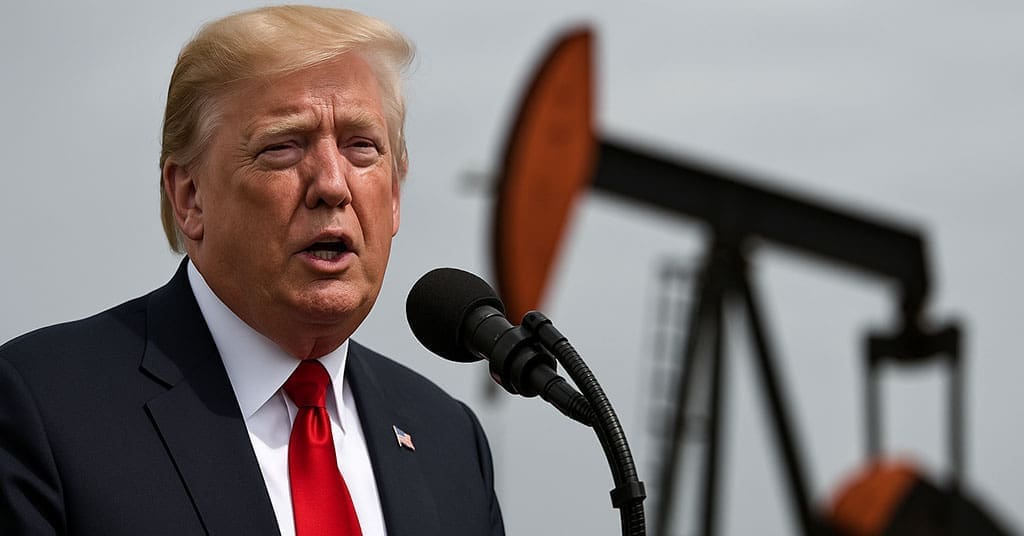IEA, OPEC and major banks slash forecasts, warning of long-term demand drag from U.S. trade actions
U.S. President Donald Trump’s aggressive tariffs on China and other key trading partners are casting a shadow over the global energy market, driving down oil demand forecasts and fuelling investor uncertainty.
Global oil demand is now expected to grow at its slowest pace in five years in 2025, with U.S. production growth also tapering off. In its latest monthly report, the International Energy Agency (IEA) slashed its 2025 demand growth forecast to just 730,000 barrels per day (bpd)—a standard industry measure—down sharply from the 1.03 million bpd forecast it made in March.
“The deteriorating outlook for the global economy amid the sudden sharp escalation in trade tensions in early April has prompted a downgrade to our forecast for oil demand growth this year,” the IEA stated, as quoted by Reuters.
That figure marks the weakest demand growth since 2020’s pandemic-driven contraction—and the lowest non-pandemic growth since 2019, when global demand rose by just 540,000 bpd. The IEA also projected a further slowdown in 2026, with growth dipping to 690,000 bpd.
Although oil, gas and refined products were technically exempt from tariffs, fears of inflation, economic slowdown and broader trade instability have weighed heavily on oil prices. “With negotiations and countermeasures still ongoing, the situation is fluid and substantial risks remain,” the IEA warned.
Slowing demand growth typically reflects broader economic concerns—less industrial output, reduced transportation activity and lower consumer energy use.
The Organization of the Petroleum Exporting Countries (OPEC) echoed these concerns, issuing its own revised forecast a day earlier. OPEC cut its 2025 demand growth estimate by 150,000 bpd to 1.30 million bpd, and 2026 growth to 1.28 million bpd. The group also lowered its global economic growth projections for 2025 and 2026 by 0.1 percentage points each.
The U.S. Energy Information Administration (EIA) followed suit, citing intensifying trade tensions with China. The EIA expects U.S. oil demand growth to flatline next year. Its measure of consumption—total products supplied—is projected to increase only marginally, from 20.51 million bpd in 2025 to 20.52 million bpd in 2026. That’s still below the pre-pandemic 2019 level of 20.54 million bpd and far from the 2005 U.S. peak of 20.80 million.
Investment banks are also adjusting their forecasts. Citi projects Brent crude could fall to US$60 per barrel—or lower—over the next three months due to demand headwinds from trade barriers. HSBC similarly lowered its 2025 West Texas Intermediate (WTI) price forecast to US$65.40 and 2026 to US$62, down about US$5 each from previous projections. The bank also trimmed global demand growth forecasts to 0.7 million bpd in 2025 and 0.8 million in 2026.
Other revised Brent forecasts include US$68.50 for 2025 and US$65 for 2026, down from US$73 and US$70, respectively.
“Tariffs, it seems, aren’t just bruising trade—they’re also putting a dent in demand optimism,” wrote Julianne Geiger at Oilprice.com.
Goldman Sachs is even more bearish, forecasting Brent at US$58 in 2026. Meanwhile, Barclays and BMI remain more optimistic with projections in the mid-to-high US$70s. JP Morgan aligns more closely with Citi in the mid-US$60s, reflecting a consensus that, barring a major geopolitical disruption, oil prices are unlikely to return to triple-digit levels.
Market sentiment has clearly turned bearish. Trump’s tariff-driven trade strategy appears to be hurting not only the global economy but also the energy sector’s momentum.
Toronto-based Rashid Husain Syed is a highly regarded analyst specializing in energy and politics, particularly in the Middle East. In addition to his contributions to local and international newspapers, Rashid frequently lends his expertise as a speaker at global conferences. Organizations such as the Department of Energy in Washington and the International Energy Agency in Paris have sought his insights on global energy matters.
Explore more on Trump administration, World economy, Energy sector
The views, opinions, and positions expressed by our columnists and contributors are solely their own and do not necessarily reflect those of our publication.
Troy Media empowers Canadian community news outlets by providing independent, insightful analysis and commentary. Our mission is to support local media in helping Canadians stay informed and engaged by delivering reliable content that strengthens community connections and deepens understanding across the country.




